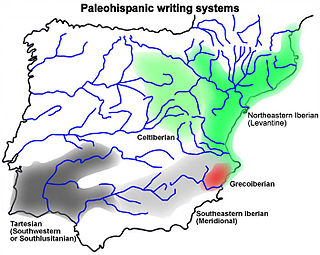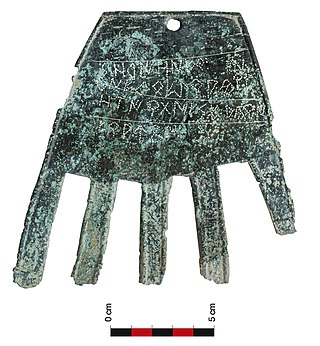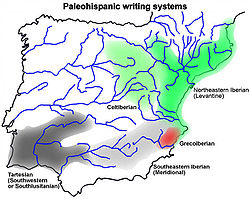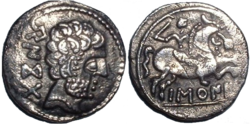Location of findings
The inscriptions that use the northeastern Iberian script have been found mainly in the northeastern quadrant of the Iberian Peninsula: largely along the coast from Roussillon to Alicante, but also with a deep penetration in the Ebro Valley. The northeastern Iberian inscriptions have been found on different object types (silver and bronze coins, silver and ceramic recipients, lead plaques, mosaics, amphores, stones (steles), spindle-whorls etc.), representing 95% of the total finds (over 2000 items), and nearly all the scripts were written from left to right. The oldest northeastern Iberian script date to the 4th or maybe the 5th century BCE. The modern ones date from the end of the 1st century BCE or maybe the beginning of the 1st century CE.
In recent years four northeastern Iberian abecedaries or signaries have been published: the Castellet de Bernabé signary, the Tos Pelat signary, the Ger signary and the Bolvir signary, all of them belonging to the dual variant of the script.
The Phoenician alphabet is a consonantal alphabet used across the Mediterranean civilization of Phoenicia for most of the 1st millennium BCE. It was the first mature alphabet, and attested in Canaanite and Aramaic inscriptions found across the Mediterranean region. In the history of writing systems, the Phoenician script also marked the first to have a fixed writing direction—while previous systems were multi-directional, Phoenician was written horizontally, from right to left. It developed directly from the Proto-Sinaitic script used during the Late Bronze Age, which was derived in turn from Egyptian hieroglyphs.

The Iberians were an ancient people settled in the eastern and southern coasts of the Iberian peninsula, at least from the 6th century BC. They are described in Greek and Roman sources. Roman sources also use the term Hispani to refer to the Iberians.
The Iberian language was the language of an indigenous western European people identified by Greek and Roman sources who lived in the eastern and southeastern regions of the Iberian Peninsula in the pre-Migration Era. An ancient Iberian culture can be identified as existing between the 7th and 1st centuries BC, at least.

The Iberian scripts are the Paleohispanic scripts that were used to represent the extinct Iberian language. Most of them are typologically unusual in that they are semi-syllabic rather than purely alphabetic. The oldest Iberian inscriptions date to the 4th or possibly the 5th century BCE, and the latest from end of the 1st century BCE or possibly the beginning of the 1st century CE.

The Celtiberian script is a Paleohispanic script that was the main writing system of the Celtiberian language, an extinct Continental Celtic language, which was also occasionally written using the Latin alphabet. This script is a direct adaptation of the northeastern Iberian script, the most frequently used of the Iberian scripts.

Lusitanian was an Indo-European Paleohispanic language. There has been support for either a connection with the ancient Italic languages or Celtic languages. It is known from only six sizeable inscriptions, dated from c. 1 CE, and numerous names of places (toponyms) and of gods (theonyms). The language was spoken in the territory inhabited by Lusitanian tribes, from the Douro to the Tagus rivers, territory that today falls in central Portugal and western Spain.

The Aquitanian language was the language of the ancient Aquitani, spoken on both sides of the western Pyrenees in ancient Aquitaine and in the areas south of the Pyrenees in the valleys of the Basque Country before the Roman conquest. It probably survived in Aquitania north of the Pyrenees until the Early Middle Ages.

Tartessian is an extinct Paleo-Hispanic language found in the Southwestern inscriptions of the Iberian Peninsula, mainly located in the south of Portugal, and the southwest of Spain. There are 95 such inscriptions, the longest having 82 readable signs. Around one third of them were found in Early Iron Age necropolises or other Iron Age burial sites associated with rich complex burials. It is usual to date them to the 7th century BC and to consider the southwestern script to be the most ancient Paleo-Hispanic script, with characters most closely resembling specific Phoenician letter forms found in inscriptions dated to c. 825 BC. Five of the inscriptions occur on stelae that have been interpreted as Late Bronze Age carved warrior gear from the Urnfield culture.
Elamite cuneiform was a logo-syllabic script used to write the Elamite language. The corpus of Elamite cuneiform consists of tablets and fragments. The majority were created during the Achaemenid era, and contain primarily economic records.

Various alphabetic writing systems were in use in Iron Age Anatolia to record Anatolian languages and Phrygian. Several of these languages had previously been written with logographic and syllabic scripts.

The Southwest Script or Southwestern Script, also known as Tartessian, South Lusitanian and Conii script is a Paleohispanic script used to write an unknown language usually identified as Tartessian. Southwest inscriptions have been found mainly in the southwestern quadrant of the Iberian Peninsula, mostly in the south of Portugal, but also in Spain.

The Paleohispanic scripts are the writing systems created in the Iberian Peninsula before the Latin alphabet became the main script. Most of them are unusual in that they are semi-syllabic rather than purely alphabetic, despite having supposedly developed, in part, from the Phoenician alphabet.

The southeastern Iberian script, also known as Meridional Iberian, was one of the means of written expression of the Iberian language, which was written mainly in the northeastern Iberian script and residually by the Greco-Iberian alphabet. About the relation between northeastern Iberian and southeastern Iberian scripts, it is necessary to point out that they are two different scripts with different values for the same signs; however it is clear that they had a common origin and the most accepted hypothesis is that northeastern Iberian script derives from southeastern Iberian script. In fact, the southeastern Iberian script is very similar, both considering the shape of the signs or their values, to the Southwestern script used to represent an unknown language usually named Tartessian. The main difference is that southeastern Iberian script does not show the vocalic redundancy of the syllabic signs. Unlike the northeastern Iberian script the decipherment of the southeastern Iberian script is not yet complete, because there are a significant number of signs on which scholars have not yet reached a consensus. Although it is believed that the southeastern Iberian script does not show any system to differentiate between voiced and unvoiced occlusives, unlike the northeastern Iberian script, a recent paper defends the existence of a dual system also in the southeastern Iberian script.

The Greco-Iberian alphabet is a direct adaptation of an Ionic variant of a Greek alphabet to the specifics of the Iberian language, thus this script is an alphabet and lacks the distinctive characteristic of the paleohispanic scripts that present signs with syllabic value, for the occlusives and signs with monophonemic value for the rest of consonants and vowels.

The Espanca script is the first signary known of the Paleohispanic scripts. It is inscribed on a piece of slate, 48×28×2 cm. This alphabet consists of 27 letters written double. The 27 letters in the outer line are written in a better hand than those of the inner line, from which it has been inferred that the slate was a teaching exercise in which a master wrote the alphabet and a student copied it.

The paleo-Hispanic languages are the languages of the Pre-Roman peoples of the Iberian Peninsula, excluding languages of foreign colonies, such as Greek in Emporion and Phoenician in Qart Hadast. After the Roman conquest of Hispania the Paleohispanic languages, with the exception of Proto-Basque, were replaced by Latin, the ancestor of the modern Iberian Romance languages.

A semi-syllabary is a writing system that behaves partly as an alphabet and partly as a syllabary. The main group of semi-syllabic writing are the Paleohispanic scripts of ancient Spain, a group of semi-syllabaries that transform redundant plosive consonants of the Phoenician alphabet into syllabograms.

The Roca dels Moros or Caves of El Cogul is a rock shelter containing paintings of prehistoric Levantine rock art and Iberian schematic art. The site is in El Cogul, in the autonomous community of Catalonia, Spain. Since 1998 the paintings have been protected as part of the Rock art of the Iberian Mediterranean Basin, a UNESCO World Heritage Site. Inscriptions in Northeastern Iberian script and in Latin alphabet indicate that the place was used as a sanctuary into Iberian and Roman times.

The Hand of Irulegi is a late Iron Age archaeological artifact unearthed in 2021 during excavations in the archaeological site of Irulegi (Navarre), next to the medieval castle of Irulegi, located in the municipality of Aranguren, Spain. The bronze artifact has the distinctive shape of a right hand with extended fingers. It has five separate strings of letters, probably corresponding to five or more words, carved on the side that represents the back of a hand.

















